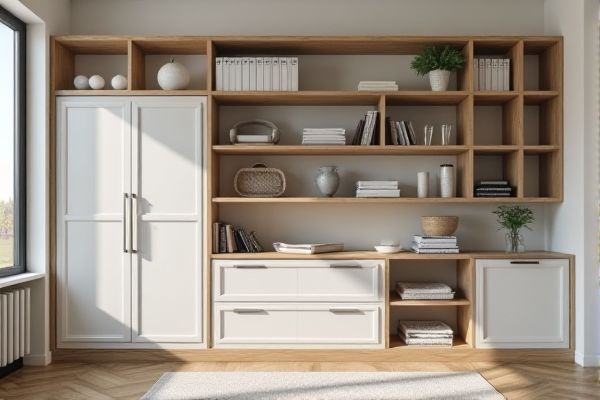
Stepped organizers maximize vertical space by providing tiered compartments that enhance visibility and accessibility of items, while flat organizers offer a single-level layout ideal for uniform storage and easy stacking. Discover which organizer best suits your storage needs and enhances your space by reading the full article.
Table of Comparison
| Feature | Stepped Organizer | Flat Organizer |
|---|---|---|
| Design Structure | Tiered or layered steps | Single-level, uniform compartments |
| Use Case | Displays items visibly with easy access | Stores items compactly without elevation |
| Space Efficiency | Optimizes vertical space | Maximizes horizontal space |
| Item Visibility | High visibility of all items | Limited visibility if items overlap |
| Best For | Office supplies, cosmetics, small tools | Drawers, shelves, general storage |
| Accessibility | Easy to reach items on different tiers | Items can be stacked, less accessible |
Introduction to Stepped and Flat Organizers
Stepped organizers feature staggered shelf heights that maximize vertical space and improve visibility of items, making them ideal for compact areas. Flat organizers have uniform shelf levels that offer straightforward, accessible storage suitable for broader surface areas. Choosing between stepped and flat organizers depends on your need for visibility versus ease of access in storage solutions.
Design Overview: Stepped Organizer
The stepped organizer features a tiered layout that enhances visibility and accessibility of items by elevating each successive row, reducing clutter and making it easier to locate belongings quickly. Its design typically maximizes vertical space, making it ideal for areas with limited counter or drawer depth, while maintaining an organized and structured appearance. This layout supports efficient storage by allowing Your items to be displayed prominently without overlapping, optimizing both form and function.
Design Overview: Flat Organizer
Flat organizers feature a simple, single-layer design that maximizes visibility and accessibility of stored items, making it easy to quickly locate your belongings. Their compact structure is ideal for drawer storage or tabletop use, providing a streamlined solution without complicated compartments or tiers. This open layout supports efficient organization for smaller spaces, enhancing usability and maintaining a neat, clutter-free environment.
Space Efficiency Comparison
Stepped organizers maximize vertical space by stacking compartments at varying heights, allowing easy access and visibility while minimizing footprint. Flat organizers spread items horizontally across a single plane, which can consume more surface area but provide uniform storage depth. When prioritizing space efficiency, stepped organizers offer superior utilization in compact areas due to their multi-level design.
Accessibility and Ease of Use
Stepped organizers provide enhanced accessibility by visually breaking down information into easily navigable, sequential steps, reducing cognitive load for users with varying abilities. Flat organizers display all content simultaneously, which may overwhelm users with extensive data sets or complex relationships, but allow quick overview and direct access to any section. Choosing between stepped and flat organizers depends on the context, user needs, and balancing clarity with comprehensive access.
Aesthetic and Style Differences
Stepped organizers feature tiered shelves that create a dynamic and visually engaging look, adding depth and dimension to a space with their layered design. Flat organizers offer a sleek, minimalist aesthetic ideal for modern interiors, providing a clean, uniform surface that emphasizes simplicity and order. The choice between stepped and flat organizers significantly impacts room style, with stepped designs conveying complexity and texture, while flat organizers highlight streamlined elegance.
Best Uses for Stepped Organizers
Stepped organizers excel in maximizing vertical storage space, making them ideal for displaying small tools, spices, or cosmetics where easy visibility and access are essential. Their tiered design allows users to quickly locate items without stacking or clutter, perfect for office desks, kitchen countertops, or workshop benches. Stepped organizers enhance organization by separating items by height, improving efficiency in both personal and professional environments.
Best Uses for Flat Organizers
Flat organizers are ideal for maximizing drawer space in kitchens, offices, and craft rooms by providing a streamlined layout that keeps items visible and easily accessible. Their low profile design allows you to sort utensils, stationery, or small tools without stacking, reducing clutter and improving efficiency. You can customize flat organizers with adjustable dividers to fit specific items, enhancing organization and quick retrieval in busy environments.
Durability and Material Considerations
Stepped organizers, often crafted from sturdy materials like metal or high-grade plastic, provide enhanced durability due to their reinforced structure and elevated design that reduces wear on each tier. Flat organizers generally use lighter materials such as wood or basic plastic, which may be prone to cracking or warping over time under heavy use. Choosing a stepped organizer can increase the lifespan of your storage solution, offering better resistance to damage and maintaining organization efficiency.
Choosing the Right Organizer for Your Needs
Stepped organizers offer tiered compartments ideal for maximizing vertical storage and easy visibility of items, making them suitable for small spaces or desktop use. Flat organizers provide a single-level layout, better for spreading out larger items or documents, perfect for wide surfaces and easy access. Selecting between stepped and flat organizers depends on your space constraints, item types, and accessibility preferences to optimize organization efficiency.
 homyna.com
homyna.com